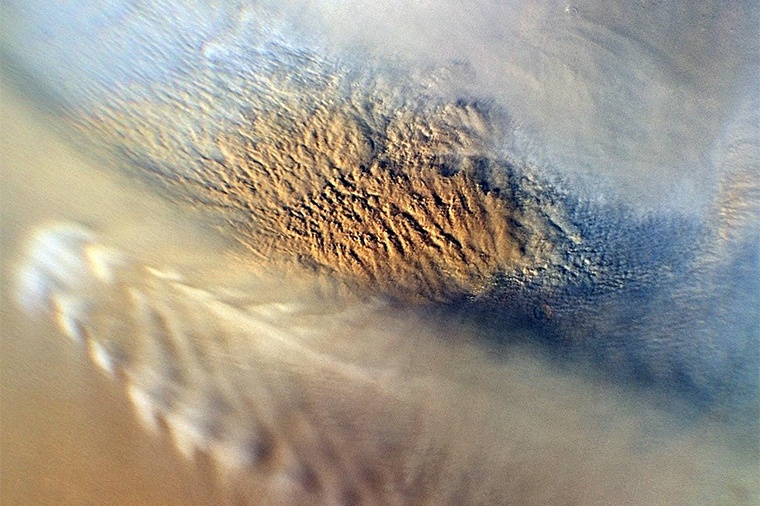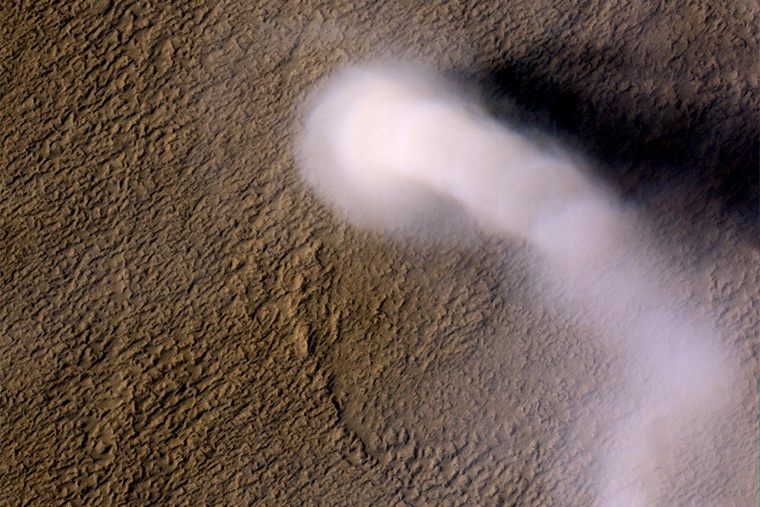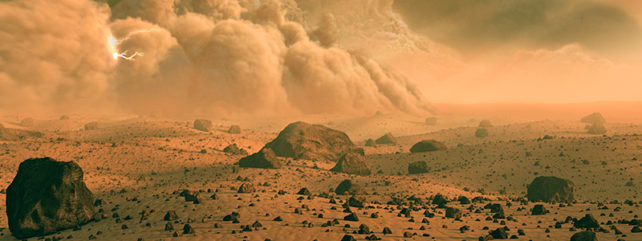Dust storms are a serious hazard on Mars. While smaller storms and dust devils happen regularly, larger ones happen every year (during summer in the southern hemisphere) and can cover continent-sized areas for weeks.
Once every three Martian years (about five and a half Earth years), the storms can become large enough to encompass the entire planet and last up to two months.
These storms play a major role in the dynamic processes that shape the surface of Mars and are sometimes visible from Earth (like the 2018 storm that ended the Opportunity rover's mission).
When Martian storms become particularly strong, the friction between dust grains causes them to become electrified, transferring positive and negative charges through static electricity.
According to research led by planetary scientist Alian Wang at Washington University in St Louis, this electrical force could be the major driving force of the Martian chlorine cycle. Based on their analysis, Wang and her colleagues believe this process could account for the abundant perchlorates and other chemicals that robotic missions have detected in Martian soil.

Dr Wang led an international team of researchers from Texas Tech University, the University of Delaware, the McDonnell Center for the Space Sciences (MCSS), and Oxford University. The paper that describes their findings recently appeared in the Geophysical Research Letters.
In it, Wang and her colleagues demonstrated how electrical discharge caused by dust storms could be responsible for decomposing chloride salts and creating atmospheric chlorine and other chemical compounds found on the surface (chlorates, perchlorates, and carbonates).
On Mars, chlorine is considered one of five "mobile elements", the others being hydrogen, oxygen, carbon, and sulfur. Like Earth's water cycle (or Titan's methane cycle), this means that chlorine is transferred between the Martian surface and the atmosphere in different forms.
It exists in gaseous form in the atmosphere, while chloride deposits are found across the surface. These deposits are similar to salt pans found across Earth, like the Bonneville Salt Flats in Utah, the Etosha Pan in Namibia, and the Salar de Uyuni in Bolivia (the largest in the world).
Similar to Earth, these chloride deposits are likely to be the dried remains of briny patches of water that existed on the surface. It is theorized that they formed from interactions between the surface and atmosphere during the Amazonian period.
This geological era extends to this day and is thought to have begun with the end of the Hesperian period (ca. 3 billion years ago) when Mars was still transitioning from a warmer, wetter environment to what we see there today (extremely cold and desiccated).
Since there is no longer exchange between the surface and atmosphere, scientists have wondered how atmospheric chlorine and chloride deposits could be linked.
In their new study, Wang (a faculty fellow with the MCSS) and her colleagues demonstrated that electrical discharges caused by dust storms are an efficient way for chlorine exchange between the surface and air. The possibility that dust storms might be a source of reactive chemistry on Mars was first proposed when the Viking 1 and 2 missions landed there in the 1970s.
However, the chemical effects of dust activities were difficult to study since the ESA's Schiaparelli lander (which would study the phenomenon) crashed on the surface in 2016.
As a result, scientists have had to stick with climate modeling and experimental studies, including research that Wang and other planetary scientists have done in recent years.
These have shown that when electrostatic discharges interact with chlorine salts in a carbon dioxide-rich environment (like the Martian atmosphere), chlorine gas is released, and perchlorates and carbonates can be generated.

However, this latest study was the first time planetary scientists attempted to quantify how much of these chemicals are produced during Martian dust storms.
This was done through a series of experiments at Washington University's Planetary Environment and Analysis Chamber (PEACh), where the team subjected various common chloride mineral salts to electrical discharges under Mars-like conditions.
As Wang indicated in a Washington University (The Source) press release, the results confirmed their theory:
"Frictional electrification is a common process in our Solar System, with Martian dust activities known to be a powerful source of electrical charge buildup. The thin atmosphere on Mars makes it much easier for accumulated electrical fields to break down in the form of electrostatic discharge. In fact, it's a hundred times easier on Mars than on Earth.
"The reaction rates are huge. Importantly, the released chlorine in a short-time mid-strength electrostatic discharge process is at a percent level. No other process that we know of can do this, especially with such quantitatively high yield of chlorine release."
During a seven-hour simulated electrostatic discharge experiment, they found that at least 1 out of 100 chloride molecules decomposed and released a chlorine atom.
In addition, the electrical discharge also accounted for the very high global concentrations of perchlorate and carbonate compounds in Martian topsoil – though the formation rates were slightly lower (sub-percent per-thousand levels). The experiment also showed that the observed concentration ranges could be accumulated within half of the Amazonian period.
Lastly, the high yields could account for the high atmospheric concentrations of hydrogen chloride observed during the 2018 and 2019 dust storms. Said Kevin Olsen, a research fellow at The Open University and a co-author of the new study:
"The high-releasing rate of chlorine from common chlorides revealed by this study indicates a promising pathway to convert surface chlorides to the gas phases that we now see in the atmosphere.
"These findings offer support that Martian dust activities can drive a global chlorine cycle. With the ExoMars Trace Gas Orbiter, we see repeated seasonal activity that coincides with global and regional dust storms."
Another interesting takeaway from this study was how the team theorized what electrostatic discharges might look like on Mars. According to Wang, the discharge would not look like a flash of lightning (as is the case on Earth).
Instead, she said, it would be more akin to a glow due to Mars' thin atmosphere.
"It could be somewhat like the aurora in polar regions on Earth, where energetic electrons collide with dilute atmospheric species," she said.
To date, no robotic missions on Mars, be they landers, rovers, or orbiters, have witnessed an electrical discharge during a dust storm. The glows would likely be obscured by the heavy dust concentrations and not be visible from orbit.
Meanwhile, surface missions that rely on solar power are forced to suspend operations in heavy storms to preserve power (as was the case during the recent storm season for the Ingenuity helicopter). But perhaps the nuclear-powered Curiosity or Perseverance rover could get a candid shot of this phenomenon before their missions are complete.
Otherwise, we might have to wait on crewed missions to see one of these "aurora", which could lead to a Mark Watney-like situation!
This article was originally published by Universe Today. Read the original article.
